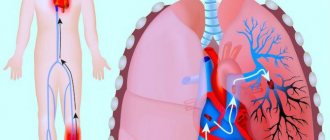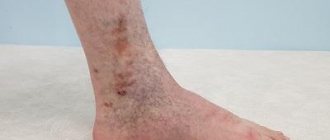Diabetes mellitus is one of the most serious health problems in the world. One of the main complications of diabetes is a blood vessel disease called diabetic angiopathy. Impaired nutrition of the nerve trunks leads to the development of another problem in patients with diabetes - neuropathy.
Diabetic angiopathy
Diabetic angiopathy is a vascular lesion that occurs in people with diabetes. In diabetes, cholesterol and calcium gradually accumulate in the walls of the arteries, which leads to their obstruction and disruption of the blood supply to the tissues.
Diabetic angiopathy is divided into two main types: microangiopathy (damage to small vessels) and macroangiopathy (damage to large main arteries), and there is often a combination of both.
Macroangiopathy develops in the vessels of the heart and lower extremities, being essentially their malignant atherosclerosis.
Microangiopathy most often manifests itself in damage to the arteries of the eyes (retinal damage - diabetic retinopathy) or kidneys (diabetic nephropathy).
Diabetic neuropathy
Diabetic neuropathy is a type of nerve damage that can occur when the vessels in the nerve trunks are affected. Diabetic neuropathy most often develops in the nerves of the legs and feet.
Depending on the affected nerves, symptoms of diabetic neuropathy can range from pain and numbness in the extremities to complete loss of sensation in the feet and hands, with the development of lesions and purulent complications.
Diabetic neuropathy is a very common complication of diabetes. However, it is often possible to prevent diabetic neuropathy or slow its progression through strict blood sugar control and a healthy lifestyle.
Causes of diabetic angiopathy and neuropathy
It is known that diabetes mellitus causes hormonal and metabolic disorders, which cause the deposition of cholesterol plaques and inflammatory changes in the walls of blood vessels, which leads to the development and clinical manifestations of diabetic angiopathy. However, not all diabetics complain of manifestations of angiopathy. This complication of diabetes depends not only on the hormonal background of a particular patient, but also on his genetic characteristics.
Diabetics with high blood pressure, smokers, and alcohol abusers have more pronounced and malignant manifestations of diabetic angiopathy.
Long-term exposure to high blood sugar can damage fine nerve fibers, causing diabetic neuropathy. The main cause of nerve damage in diabetes is considered to be microangiopathy of the vessels supplying the nerves. Their blockade in diabetic angiopathy leads to a deficiency of oxygen and nutrients in the nervous tissue and to the death of nerve fibers.
Why does angiopathy develop?
As mentioned earlier, the initial problem of all diabetics is atherosclerosis, that is, thinning of blood vessels. Constant exposure of the body to sugar and insulin in large quantities makes them fragile, and poor nutrition contributes to the growth of plaques.
But this is not the only reason that gives impetus to the development of diabetic angiopathy of the lower extremities. Among the factors that contribute to the onset of the disease are:
- Obesity, leading to an increase in the amount of cholesterol in the blood.
- Hypertension.
- Alternation of hyperglycemia and hyperinsulinemia.
- Damage to the peripheral nerves of the legs.
- Individual anomalies of bones and muscles.
- Raynaud's syndrome leading to ischemia.
- Smoking.
Together with atherosclerosis, these disorders accelerate the process of destruction of blood vessels, and manifestations of angiopathy become obvious faster.
Types of diabetic angiopathy
Diabetic nephropathy develops when the small arteries of the kidneys are damaged and leads to disruption of their function, up to the development of severe renal failure. Diabetic nephropathy is manifested by the appearance of protein in the urine, severe arterial hypertension, and increased levels of creatinine and urea in the blood.
Diabetic retinopathy develops when the retinal arteries are damaged. It is characterized by changes in the vessels of the fundus and hemorrhages in the retina. Can lead to retinal detachment and complete blindness.
Angiopathy of the lower extremities in diabetes mellitus develops through four stages:
- The first stage has no clinical symptoms, however, when examining the vessels, thickening of the arterial walls and their calcification can be detected.
- The second stage is manifested by the appearance of pain when walking over a certain distance (intermittent claudication)
- The third stage is characterized by the appearance of pain in the legs at rest, especially when lying horizontally. If you lower your legs, the pain decreases significantly.
- The fourth stage is manifested by the appearance of trophic ulcers and necrosis on the legs, and diabetic gangrene often develops. This condition is called diabetic foot syndrome.
Symptoms
The symptoms of the disease, especially in the early stages, are similar to the main symptoms of other ailments associated with impaired blood supply to the blood vessels of the legs: read more about them here. These are painful sensations when walking, increased fatigue, turning into intermittent claudication. In severe forms of the disease, patients experience signs of obliterating atherosclerosis: numbness, tingling, discoloration of the skin of the legs, poorly healing wounds and ulcers. In the later stages of the disease, signs of “diabetic foot” appear - deformation of the bones and joints of the foot, skin changes.
Types of diabetic neuropathy
There are four main types of diabetic neuropathy. Most develop gradually, so this complication may not be noticed until serious problems arise.
Peripheral polyneuropathy
Peripheral neuropathy is the most common form of diabetic neuropathy. First, problems with sensitivity develop in the legs, then signs of neuropathy may appear in the arms. Symptoms of peripheral neuropathy are often worse at night and may include:
- Numbness or decreased ability to feel pain or changes in temperature.
- Tingling or burning sensation.
- Sharp pain or cramps.
- Increased sensitivity to touch - for some people, even the weight of a sheet can be excruciating.
- Muscle weakness.
- Loss of reflexes, especially in the ankle.
- Loss of balance and coordination.
- Serious foot problems such as ulcers, infections, strains and bone and joint pain.
Autonomic neuropathy
The autonomic nervous system controls the heart, bladder, lungs, stomach, intestines, genitals and eyes. Diabetes can affect the nerves in any of these organs, which can cause:
- Problems with urination - urinary retention or incontinence due to damage to the autonomic innervation of the bladder.
- Constipation or uncontrolled bowel movements.
- Slowing of gastric emptying (gastroparesis), leading to nausea, vomiting, bloating and loss of appetite.
- Difficulty swallowing
- Impaired potency in men
- Vaginal dryness and other sexual disorders in women
- Increased or decreased sweating
Diabetic amyotrophy
Diabetic amyotrophy affects the large nerves of the limbs, such as the femoral and sciatic nerves. Another name for this condition is proximal neuropathy, which most often develops in older people with type 2 diabetes.
Symptoms usually occur on one side of the body and include:
- Sudden, severe pain in the hip or buttock
- Thigh muscle atrophy
- Difficulty getting up from a sitting position
Mononeuropathy
Mononeuropathy involves damage to a specific nerve. The nerve may be in the face, torso, or leg. Mononeuropathy is also called focal neuropathy. Most often found in older people.
Although mononeuropathy can cause severe pain, it usually does not cause any long-term problems. Symptoms gradually decrease and disappear on their own after a few weeks or months. Signs and symptoms depend on the specific nerve affected and may include:
- Double vision due to damage to the oculomotor nerve
- Facial paralysis with facial asymmetry
- Pain in the lower leg or foot
- Pain in the lower back or pelvis
- Pain in the anterior thigh
- Pain in the chest or stomach
- Weakness in the hand, with damage to the nerves of the brachial plexus.
Main symptoms of the disease
Manifestations of the disease vary and depend primarily on its stage. First of all, most patients report pain. At first, it makes itself felt only after long walks, but later, it is enough to stand on your feet and take a few steps to feel the pain. Then the list of symptoms grows week after week:
- Small red or purple spots appear on the skin.
- The feet often experience itching and burning.
- There is a feeling of coldness and numbness in the legs, even in a warm room.
- Scratches and wounds on the skin heal slowly.
- The first ulcers, swelling, and bluish skin appear.
- The skin becomes very dry, and the nails become split, but at the same time they can thicken.
In the severe stage of the disease, life-threatening symptoms develop, such as tissue death of the lower extremities, gangrene, heart failure and blindness.
Diagnosis of neuropathy and angiopathy
The diagnosis of diabetic neuropathy is based on symptoms, history, and clinical examination. During the exam, your doctor may check your muscle strength and tone, tendon reflexes, and sensitivity to touch, temperature, and vibration.
Additional diagnostic tests:
- Nerve conduction studies. This test checks how well the nerves in the arms and legs conduct electrical signals.
- Electromyography (EMG). Often performed in conjunction with nerve conduction studies, electromyography measures the electrical discharges produced in your muscles.
- Quantitative sensory testing. This non-invasive test is used to evaluate how responsive nerves are to vibration and temperature changes.
- Vegetative testing. The reaction of blood pressure in different body positions and the ability to sweat are assessed.
Features of the disease
The development of damage to the circulatory system against the background of diabetes mellitus is accompanied by:
- compaction of vascular walls;
- lipid and cholesterol deposits on the endothelium;
- thrombus formation;
- decrease in vascular lumen;
- formation of swelling and increased exudation;
- disruption of the trophism of cells and tissues up to their death.
Since capillaries have the smallest lumen among all arterial-type vessels, they suffer first. This means that the process of damage begins with the toes, feet, then moves to the legs and reaches the thighs.
Treatment of diabetic angiopathy
Compensation for diabetes mellitus is the basis of treatment for diabetic angiopathy. It is necessary to reduce blood glucose levels to normal values using glucose-lowering drugs; in severe cases of diabetes, it is necessary to use insulin therapy.
If objective signs of arterial damage (narrowing, calcification) are detected, it is advisable to constantly take angioprotectors (Vessel Due F), antithrombotic drugs (aspirin, Plavix), and vitamins.
Signs of severe angiopathy, with circulatory disorders in organs and limbs, should be the reason for active surgical treatment. In case of damage to the arteries of the leg, heart and kidneys, it is advisable to restore blood circulation using endovascular surgery methods (angioplasty and stenting). This will prevent the development of severe complications such as gangrene, myocardial infarction, and renal failure.
Diabetic angiopathy is a very dangerous disease that can be fatal. When the first symptoms of angiopathy appear, a patient with diabetes should immediately visit an experienced doctor specializing in this problem.
How the disease develops
Experts distinguish two main degrees, following each other. The first is microangiopathy. It suffers only from minor symptoms that do not affect the appearance of obvious signs of the disease. Angiopathy can be detected at this stage only during a medical examination, so patients almost never receive timely treatment.
The second degree is macroangiopathy. With it, the disease affects important large vessels and gradually all the symptoms mentioned above appear. The danger to general well-being increases; not only the lower limbs suffer, but also other important organs of the body: kidneys, heart, and so on. It is additionally worth noting that microangiopathy without subsequent development of macroangiopathy practically does not occur.
Treatment
The basis of treatment for any complications of diabetes mellitus is stabilization of glycemic indicators. A patient with the first type of diabetes requires adjustment of insulin doses; in the case of the non-insulin-independent type, the regimen of taking glucose-lowering drugs is changed (Maninil, Tolbutamide, Glimepiride, Glirid, Diabeton Acarbose, Miglitol, etc.). Angiopathy is practically not amenable to eradication (complete elimination), so treatment is aimed at alleviating symptoms and inhibition of the development of pathologies. Categories of prescribed medications:
- diuretics (diuretics);
- drugs that reduce vascular permeability and normalize metabolic processes in the vascular wall (angiotensin-converting enzyme (ACE) inhibitors);
- α-lipoic (thioctic) acid;
- antispasmodics and non-steroidal anti-inflammatory drugs;
- acetylsalicylic acid preparations for blood thinning;
- medications that regulate the neuropsychological process (nootropics);
- drugs that prevent blood clots (antiplatelet agents).
Important! A prerequisite for therapy is strict adherence to the diet. The choice of drugs and treatment tactics depend on the type of angiopathy.
Causes
The development of pathology depends on diabetic factors - high levels and unexpected surges in plasma sugar.
With type I diabetes, the chance of pathology occurring is lower because the patient is able to manually control glucose levels using insulin.
Diabetics of the second type are at risk - the presence of insulin breakdown products in the body leads to inevitable surges in glucose levels.
Among other factors causing the occurrence of vascular angiopathy of the lower extremities, the following should be highlighted:
- Insensitivity of body structures to insulin;
- Dyslipidemia is a disorder of the metabolism of fats and protein complexes;
- Overweight, sedentary lifestyle. Visceral obesity has a greater effect - accumulation of fat in the gastrointestinal tract - abdomen;
- Arterial hypertension, increased blood clotting;
- Smoking and harm caused by the characteristics of the patient’s place of residence or work;
- Heredity, as well as age. Diabetics over 50 years of age are at risk.
Main reasons for development
Problems with blood vessels in diabetics begin from the moment endocrine pathology is diagnosed. This is reflected in increased blood pressure. As the disease progresses, vascular lesions become larger. The causes of violations are incorrect diabetes therapy or its absence, non-compliance with the diabetic diet, and the presence of concomitant diseases affecting the vascular system. One of the significant factors influencing the occurrence of angiopathy is nicotine addiction and alcohol abuse.
Signs of diabetic encephalopathy
When encephalopathy occurs, a diabetic begins to experience memory impairment and confusion. In addition, the patient complains of constant headache and fatigue. This pathology is a consequence of a circulatory disorder in the brain.
At the beginning of the development of the disease, a person may not feel any symptoms. But over time, the patient becomes dependent on painkillers due to frequent headaches. This, in turn, leads to sleep disturbance and drowsiness during the day. Subsequently, the patient becomes distracted and forgetful.
In addition to general cerebral symptoms, focal symptoms develop, which include impaired coordination of movements, pathological reflexes and an unsteady gait. A dangerous sign is considered to be convergence disorder, that is, double vision, blurry pictures, blurred vision, abnormal adaptation of posture. In addition, anisocoria occurs - a condition in which there is a different diameter of the pupils.
Such pathological processes are dangerous for the patient when performing work related to various mechanisms, as well as driving a car.
- Diabetic angiopathy of the lower extremities
Diagnostics
With such problems, you can contact an angiosurgeon or endocrinologist. After examination and collection of complaints, the doctor prescribes laboratory, instrumental and hardware assessment of the following indicators:
- biochemical screening – glucose, creatinine, urea levels, blood clotting status;
- ECG, echo CG at rest and with exercise;
- X-ray examination;
- arteriography of the lower extremities - assessment of patency using a contrast agent;
- Dopplerography - ultrasound examination of the condition of blood vessels;
- in the presence of purulent discharge from an ulcer - bacteriological examination with an antibiogram;
- determination of transcutaneous tension - assessment of oxygen levels in the tissues of the extremities;
- computer capillaroscopy.
Diagnostic procedures are carried out not only to make a diagnosis, but also during treatment to assess the condition of the vessels over time.
Treatment methods
The basis of therapy for angiopathy is to bring carbohydrate metabolism in the body to normal. Therapy involves following a diet and taking medications that lower sugar levels.
Conservative treatment
It consists of using medications that help improve blood flow and normalize blood composition.
The drugs used are included in the following groups:
- Statins that lower cholesterol;
- Antioxidants that dilate blood vessels;
- Medicines that reduce blood clotting; those struggling with hypertension; provoking tissue restoration;
- Angioprotectors, metabolic agents, biogenic, vasoactive and diuretic substances are also used;
In addition, neurotropic substances and vitamins can be used in various situations.
Surgery
Surgeries are used to restore the original state of blood vessels or remove dead tissue.
Three types of operations that restore blood flow are used for treatment:
- The minimally invasive method helps clean the blood vessels;
- Endovascular serves the same purpose, but is performed in a segmented manner;
- Bypass surgery is used in more severe situations to direct blood flow past blocked vessels.
There are several other interventions used for angiopathy of the lower extremities. Lumbar sympathectomy – serves to restore blood flow. In severe clinical situations, the surgeon is forced to amputate dead tissue or completely remove a limb in case of gangrene.
Physiotherapy
The influence provided by the process is considered auxiliary and is not used often. For angiopathy of the lower extremities, the doctor may recommend the following procedures:
- Magnetic therapy;
- Treatment with mud baths;
- Massage.
Our advantages
"Moscow Eye Clinic" offers comprehensive diagnostics and effective treatment of eye diseases. Modern equipment and the high professional level of specialists working in the clinic eliminate diagnostic errors.
Based on the results of the examination, each visitor will be given recommendations on choosing the most effective methods of treating the eye pathologies identified in them.
Preventive measures
To prevent complications of diabetes, it is necessary to continuously monitor the disease. Prevention is based on compliance with the following rules: daily repeated measurement of sugar and blood pressure, a strict diabetic diet, regular visits to an endocrinologist, an annual full examination by a nephrologist, cardiologist, and ophthalmologist.
It is also necessary to take prescribed medications, perform a complex of exercise therapy, and eliminate bad habits (alcohol, smoking). Micro- and macroangiopathy are observed in 90% of cases of diabetes mellitus. The goal of a diabetic is to change their lifestyle in order to delay the development of complications as much as possible. If signs of complications appear, you should immediately seek medical help.










